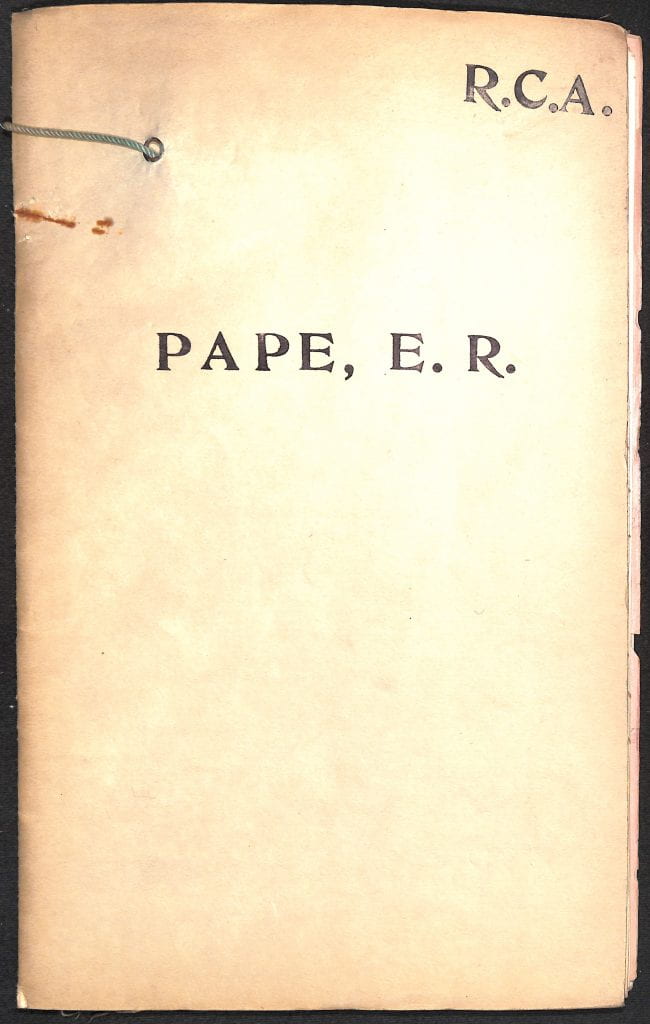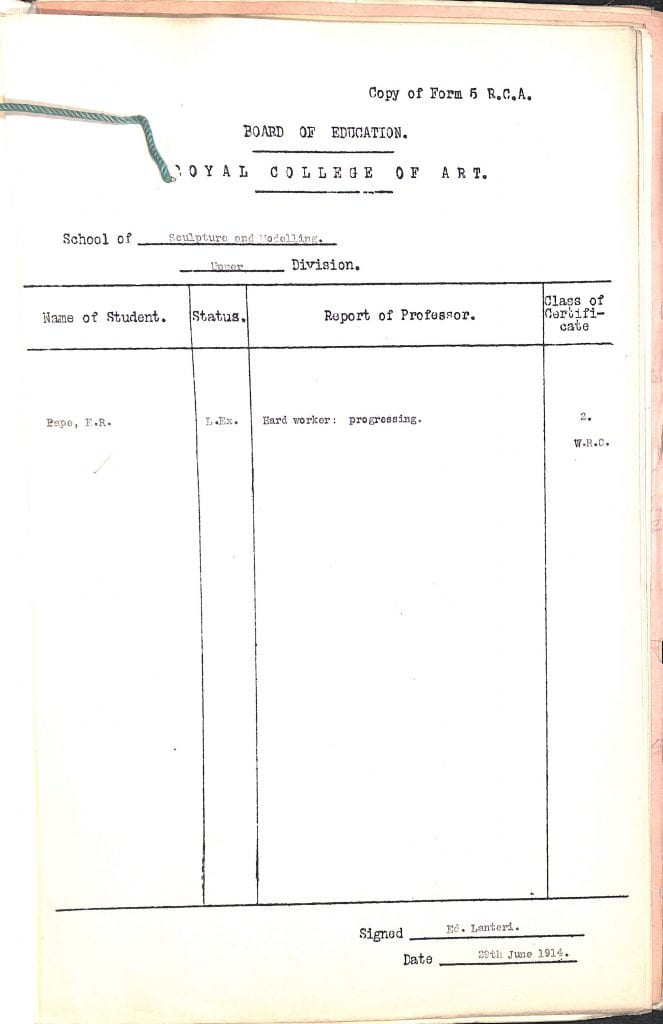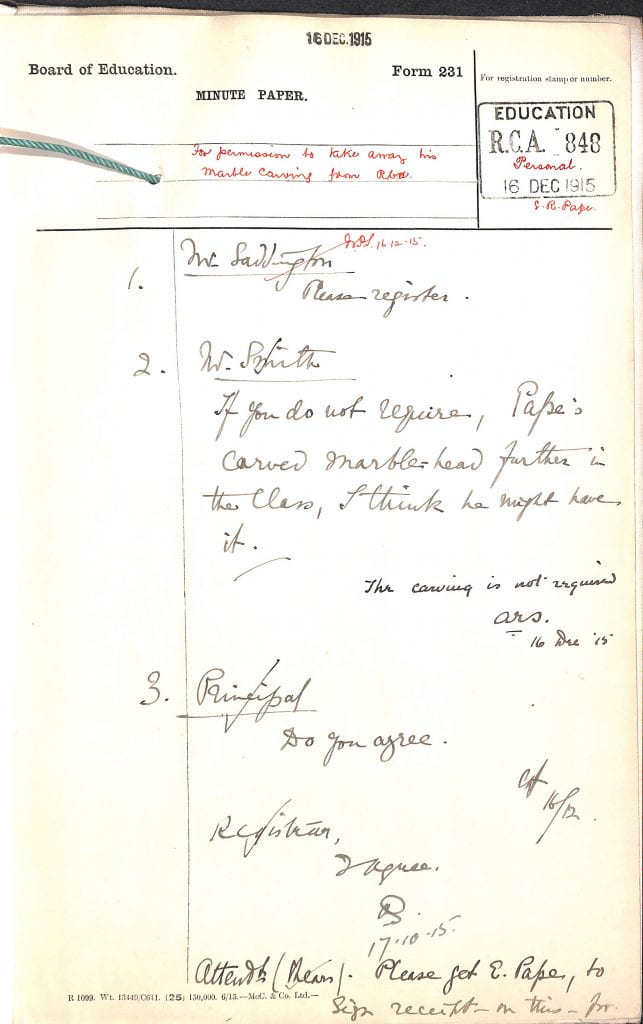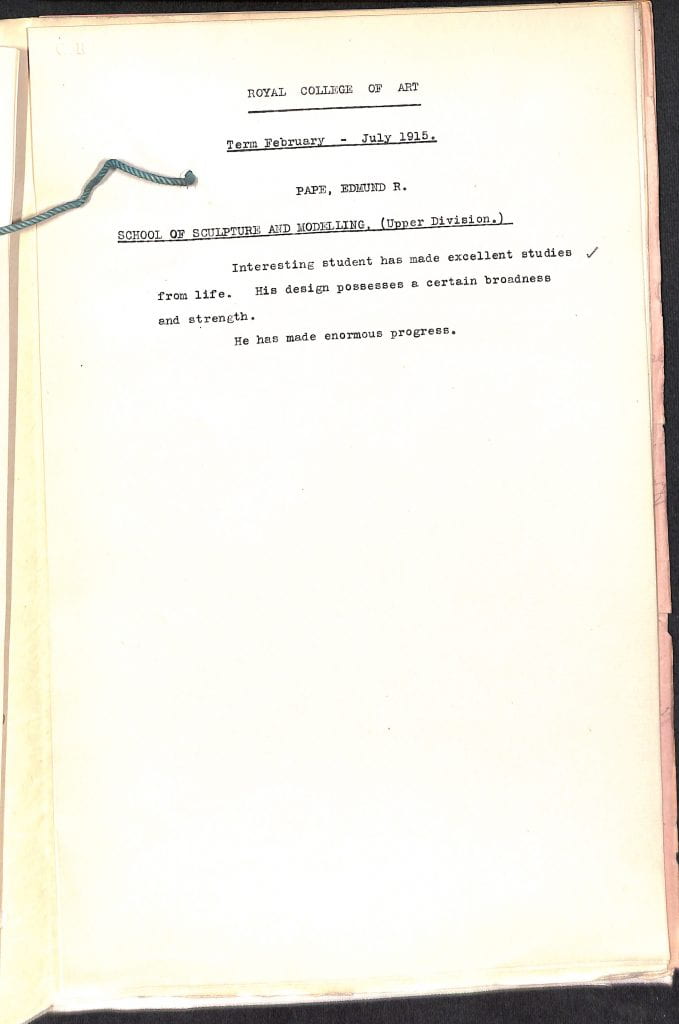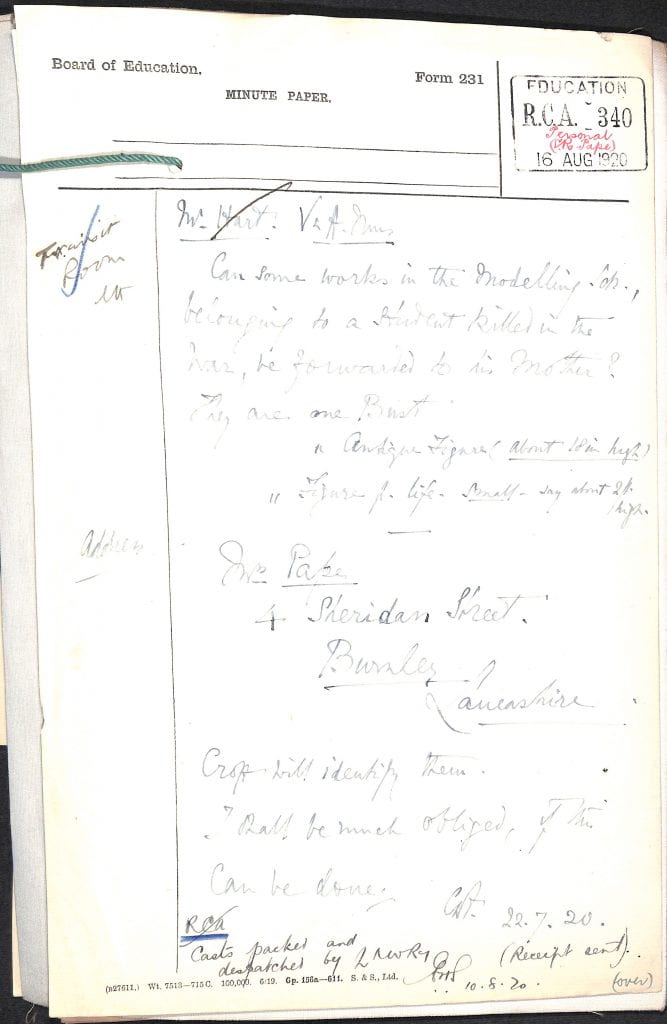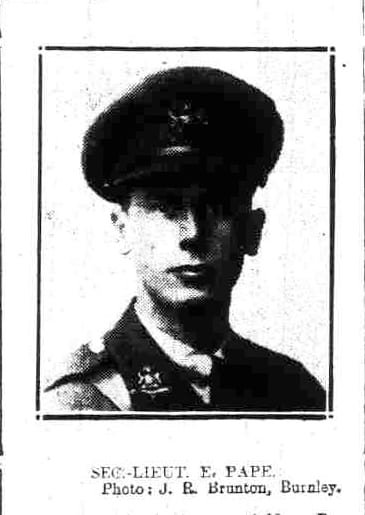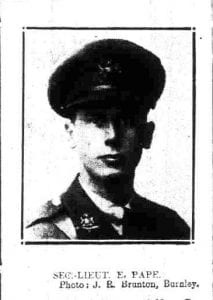
Born: 27 August 1893
Died: 27 March 1918
Studied at the RCA: October 1912–January 1916
Edmund came to the College from Burnley, Lancashire, having attended its art school and won a local scholarship. He was a middle child, with an older and a younger sister, in the second family of Robert, a widowed farmer with three older children. Robert is described in the 1911 Census as a clothing company agent, married to Edmund’s mother, Amanda M. Pape, who by this date was the head teacher of Briercliffe Infant School. Edmund wrote in his College admission forms that he had experience of ‘Designing & Modelling Architectural ornament for Buildings’, and clearly sculpture, carving and modelling remained his focus for the next three years. His reports note he was ‘Good and capable’ and an ‘Interesting’ student who made ‘Great progress’. In the summer of 1915 he duly received an ARCA diploma in Modelling. Planning to become an art teacher, he registered to continue at the College the following autumn, but like other students who had volunteered early in the war under the Lord Derby Scheme, his studies were interrupted. On 24 January 1916 he joined the army.
From February 1916 Edmund served in the Territorial Force’s 1/16th (County of London) Battalion (Queen’s Westminster Rifles), often more succinctly referred to as the QWRs. Having received at least a few weeks of infantry training – learning to handle a range of weaponry (perhaps in Richmond Park or Winchester) – Edmund arrived in France on 5 July. It is possible he was in a draft of over two hundred soldiers that joined the QWRs (now part of 169th Brigade, 56th Division), following a misjudged and wasteful diversionary attack on the village of Gommecourt (south-west of Arras) on 1 July, the first day of the Battle of the Somme. As a distraction from operations taking place elsewhere it was a total failure and, perhaps more significantly, resulted in many casualties.
Edmund’s service file has not survived, but when the QWRs were relieved from the waterlogged trenches in the middle of the month, undoubtedly he would have begun to experience the familiar pattern of service for most soldiers: fatigue duties (such as trench repair), marching, training, and relieving other battalions as fighting continued through the summer. When autumn arrived the division took over the line east of Guillemont, near Albert. During September and October they took part in a series of battles – Ginchy, Flers-Courcelettes, Morval (capturing Combles), and Transloy Ridges – revealing that the once inexperienced volunteers from the Territorial Forces had begun to cohere as an effective fighting force.
It may be for this reason – esprit de corps – that Edmund refused, at least for the rest of the year, to train for a commission, the assumption being that becoming an officer would mean moving on to another regiment entirely. At some point he was, however, promoted to sergeant – perhaps even before departing for France – and as a non-commissioned officer (an NCO) was able to remain, for the time being, with the battalion he knew well.
Edmund served with the QWRs (in the Third Army) at the Battle of Arras in April 1917, the initial aim of which was to capture Vimy Ridge, thereby diverting German forces’ attention away from the French army to the south. As part of this the QWRs fought in both the first and third battles of the Scarpe, advancing on Douai and beyond. But although the British attack gained much ground at first, as time passed the German defence rallied and no sustained breakthrough was achieved. Stalemate soon returned to the battlefields, with several mutinies breaking out in the demoralised French forces after disastrous fighting (and losses) near Laon.
By June Edmund was on leave, back home visiting his family. The Burnley News (23 June) reported, somewhat breathlessly, that ‘Sgt. Pape, who looks in the pink of condition, has recently returned from exceedingly strenuous and dangerous work in the Somme district where he has had some almost miraculous escapes’. It also notes that he was shortly to return to Wimbledon Camp (although another later report mentions Pirbright in Surrey) to undergo officer training. His commission came through in either late October or November 1917. He would no longer serve with the QWRs.
In January 1918 the war diary for the 2/5th Battalion, Manchester Regiment (part of 199th Brigade, 66th Division), based near Ypres, notes soldiers who have been in hospital and had ‘Re-joined the battalion during the month…’. Edmund appears mistakenly as one of these, but crossed through, with a pencilled correction marking him instead as ‘(new)’. This confused reference is the only time he is mentioned individually: he is not even in the following month’s usual list of battalion officers. Such errors and omissions suggest the underlying difficulties facing the organisation of the British Expeditionary Force at the time, when a shortage of men meant many distinct battalions and regiments were combined into new ‘composite’ battalions. The price of this was the loss of their identity but also, and more importantly, the restructure could not conceal that some divisions remained under strength. The need for relatively experienced men, such as Edmund, must have been considerable, but even so there was little time for the wide-ranging changes to bed-in and new faces to become familiar- with many 199th Brigade officers seemingly on courses or leave – when the German army suddenly launched their Spring Offensive on the foggy morning of 21 March.
The 2/5th Manchesters joined other battalions in the Fifth Army in an area almost halfway between Amiens (British) and St Quentin (German). At the start of the German attack they were holding the front line near Villeret Ridge, but were unable to prevent fresh and well-prepared German forces breaking through time and again over the next few days. On the 23 March the Manchesters were ordered to hold the bridge-head at Barleux, but disorganisation grew as they, and the other battalions, sustained many losses – some apparently under ‘friendly fire’ because of poor visibility and, perhaps, panic. The Brigade war diary from 27 March shows its battalions ordered to retreat again and again westwards as they were repeatedly almost surrounded, while the last entry for the month lists Edmund as one of sixty-three missing officers.
In September, enquiries sent to the Red Cross from both his uncle and his mother proved fruitless: he was not one of the many thousands captured that week who became prisoners of war. Instead, his death was eventually deemed to have occurred the same day he went missing: 27 March 1918.
Edmund is commemorated at home in St. Peter’s Church, Osmotherley, and St. James’ Church, Briercliffe, as well as on the Pozières Memorial, Hautes-de-France, along with over 14,000 soldiers of the Fifth and Fourth Armies with no known grave.
